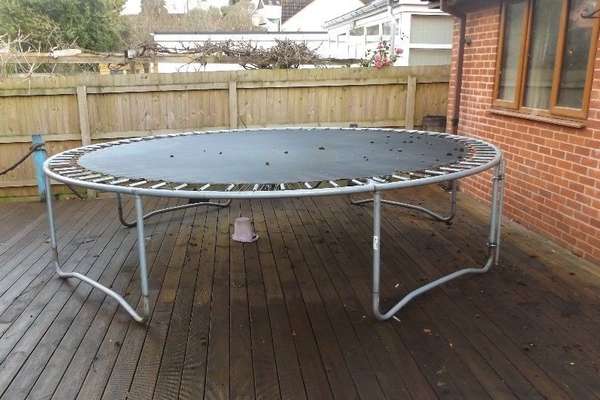
Do’s and Don’ts About Trampoline on Decking
Getting our children a trampoline is a great way of becoming the parent of the year. However, in terms of safety, trampolines are a bit tricky. We need to find a good place to set them up, and we need to make sure that our kids are safe at all times.
Most parents would agree that setting up a trampoline on soft grass is the ideal solution. Nevertheless, we don’t all have enough space in our backyards for such an endeavor. Yet, what most of us have is decking. So, placing a trampoline on decking might be a fine idea if we don’t have another option. But what should we pay attention to?
Can you use a trampoline on decking?

When properly secured, using a trampoline on decking is possible. However, doing so depends on the type of decking we have, the type of the trampoline we are going to buy and our ability to secure it in place. Furthermore, it depends on how much our children will use it, as well as how many of them will jump on it.
Can you put a trampoline on decking?
Putting a trampoline on decking is possible, but there are safety precautions we need to be aware of. We have to consider the overhead clearance and the horizontal clearance. Moreover, we have to take the weight of the trampoline and our children into account as well.
There should be enough space above the trampoline, as well as on the sides. Furthermore, we need to respect the weight limit at all times, as going over it means more damage to our decking. So, before deciding on a trampoline, we need to make sure our decking can handle all that bouncing. What’s more, it has to handle our children’s weight without breaking apart.
Is it safe to put a trampoline on decking?
The answer to this question depends on the type of decking we have. If we have a wooden decking, we might be able to secure the trampoline with sandbags. Moreover, it’s a lot safer to use a trampoline on decking if there’s enough overhead and horizontal clearance. That way, our children can bounce all day long, never fearing that they’ll hit their heads on something.

But using a trampoline on decking is usually only as safe as our decking is strong. Therefore, we don’t advise placing trampolines on decking that don’t have enough support or are made from a cheap material that’s prone to damage. Furthermore, we advise using enclosed trampolines only, as the enclosure will help our children stay safe while jumping.
One way of preventing damage is putting foam or rubber under the legs. But again, if our decking is naturally weak, all that bouncing could put our children (and our decking) in jeopardy.
Overall, putting a trampoline on wooden decking can be made safe if we have enough time and will. However, certain sacrifices are due in order to achieve perfect safety.
How to secure a trampoline on decking
Securing a trampoline on elevated decking will prove to be quite a problem. In essence, we would have to use anchors or sandbags and tie-downs to make it as safe as possible. Thus, damaging our decking in advance is a given. In order for the trampoline to stay put, we would have to find a way to drill holes in our decking and use the anchors and tie-downs to secure the trampoline directly onto it. But, to be honest, that’s not the best solution either, as the impact energy could destroy our decking in the end. Moreover, anchors are not meant for decking at all.
Therefore, we would advise against using a trampoline on an elevated decking. However, on a non-elevated decking, even though the method would essentially be the same, securing a trampoline would be a bit easier.
Our ground decking is a bit hollow on the inside, which means that if we drill holes through it, we could secure the anchors to the ground. However, if there’s a weed membrane underneath it, as well as a sub-base of rocks, for example, our efforts might be in vain; not to mention that our decking would be somewhat destroyed.
So, in the end, there’s only so much we can do with our trampoline, which is why sandbags are probably our best option. We have to keep in mind that these are hard to fill, although they don’t require any holes at all. Moreover, they are not really durable and can look quite unattractive. Nevertheless, when you weigh out the pros and cons, sandbags are a better solution. At least that way, our decking will stay in good condition.
Trampoline under decking
Although this might seem like a viable option, we ought to avoid putting a trampoline under decking. It all comes down to the overhead clearance we talked about earlier. Our children need to be as safe as possible, and that entails having enough space above their heads for jumping. There should be a minimum of about 7 meters of overhead clearance.
Sunken trampoline on decking
A sunken trampoline just might be the ideal solution for our homes. Since this trampoline is secured in the decking, it won’t move at all. Of course, that means that we cannot move it as we wish. However, the safety it gives us is more than we could ever hope for. And of course, if the sunken trampoline has an enclosure (although it usually doesn’t need it), it will be very easy to keep our children safe while they’re bouncing up and down.
The gist of it is that the decking will serve as another safety measure that won’t allow the trampoline to move around. It will keep it in its place, no matter how much our children jump on it. Furthermore, the decking can also serve as a great solution if the ground is not level.
In essence, we’re getting the best of both worlds this way. Our decking will keep the trampoline safe, but it won’t be destroyed by it.
Looking for a trampoline? Don't buy something you'll hate
Here is a list of our buying guides to help you find the best for your needs:
In conclusion
Putting a trampoline on wooden decking requires a lot of work in terms of safety. Essentially, we have to secure it in the best way possible, and as tightly as possible. Otherwise, we are risking our children’s lives as the trampoline can otherwise easily move and slide off the decking.
If we don’t have much choice or not enough space on soft grass in our backyard, then yes, placing a trampoline on decking is a possibility. Nevertheless, we should only place it on ground decking and make sure that all our safety expectations are met before our children even step onto it.

